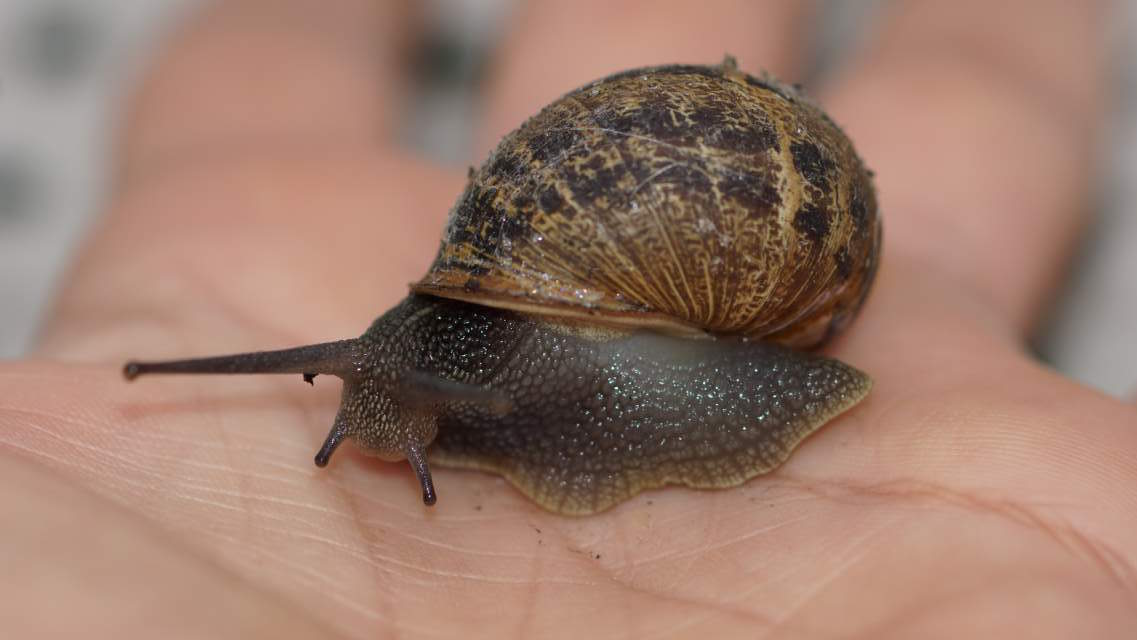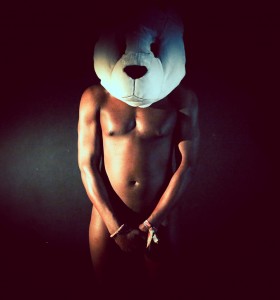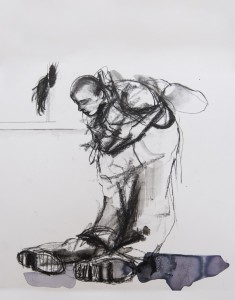Snail trails, bear-baiting, and Rice Krispies. Miriam King witnesses three performance works at National Theatre Studio on the last day of SPILL Festival 2015
The durational Snail Portrait, performed over four hours, is a new immersive work combining performance, visuals, text and installation, inspired by the Persian phrase ‘khane be doosh’, meaning ‘home on your back’. Shabnam Shabazi creates an aural and visual ‘listening room’, exploring what it means, or more like, how it feels to be, without a permanent home, yet always carrying your past with you. Going into the room, the lights are low, there is a strong, pleasant perfume, and the striking image of an immobile, horizontal, resting person within a perspex case, their body and all about them swathed in trailing ivy, with large snails being carefully placed on the exposed areas of flesh. The lower part of the moist case contains lily plants. Returning later, many many snails are now finding their way, and leaving their glistening trails across the belly, face, nose, closed eyes, arms, legs, hands of the woman. The soundtrack tells me snails are hermaphrodite, have no eyes, no hearing, yet a strong sense of smell, and breathe through their skin. They, in turn, are on this woman’s skin, creating glistening trails; and her breath, deep in her belly, rises and falls with their searching forms. I could watch and watch and watch. The soundtrack is rich – texts that are partly autobiographical, partly factual – and I sit silently to witness and listen.These snails, gentle and fluid, their path in constant flux, sensing where to go, carrying their homes on their backs, their shelter. It’s calm, it’s otherworldly. A place to be, to sense, and to contemplate.
In sharp contrast, Jamal Harewood presents The Privileged. On the floor amongst scattered KFC pieces, is a polar bear called Cuddles. Or rather, a human wearing a polar bear outfit, and we, a 50-strong audience, have between us ten envelopes, containing instructions. Through these instructions we are led, perhaps coerced, into exercising power over him. For example, there are instructions for us as a group to nominate someone to wake Cuddles up, progressing through to removing his costume, then feeding him, then preventing him overeating. We, as a group, decide what to do, and people elect to do it. Yet once the grubby white costume is off – and this takes a while, as the first person who gets up to do this cannot achieve this in a ‘kind’ way, someone else takes over and rips the costume off in a forceful way, which results in audience/group members leaving the ‘enclosure’ – we’re no longer dealing with someone play-acting a polar bear, lumbering around, sniffing and pawing at our bags, but instead a physically powerful and vulnerable man: no longer within the funny playsuit and oversized white head, yet naked and cowering within his black skin. He is vulnerable, at the whim of our decisions, yet this whole thing is something he has set up, has cleverly written. We, the audience, are the vulnerable ones. People got very choked up, some had to take a walk outside of the building, others were in tears, as it was very challenging to watch and witness what followed. I didn’t want to leave, as I wanted the situation resolved, yet to resolve something, that involves having to ‘do’ something, which can then create conflict. Like two sides of a coin: to resolve something, or to let the situation evolve? To let it play out, a natural evolution – but by whose rules does it play out? In the post-show discussion, self facilitated and audience led, and without the artist present, one of the main questions was: at what point did the performance change from something playful, a game that we were all party to, to something uncomfortable, something disturbing? Some felt ‘bad’ and tearful. Others thought we were all complicit in an agreed action. It was a performance after all, created by the artist – not real life. Others felt ‘responsible’. Some felt that although this was a performance, the artist’s emotions were very real. There is historical context here, with echoes of the works of Marina Abramovic, and other artists who have created scenarios where audience members are invited to engage with the artist’s body. Since those historic performances, the issue of ‘consent’ has moved to the forefront of discussion.
The Machinist, Circa 1986, created and performed by Debbie Guinnane is a 100-minute durational solo performance with concerns over body dysmorphia and eating disorders. There are four varied performance ‘stations’ containing everyday items such as a large fridge and other domestic stuff. The audience are sat on the floor or leant against walls. At some points the artist seems to be near naked. At other points, she is wearing white overalls. There’s a soundtrack talking about Karen Carpenter (who had anorexia and died young) playing as she pours Rice Krispies into a large bowl and adds a large quantity of milk till the cereal brims up and spills over the floor. Now she’s wearing a fox fur around her neck, then across the top of her head, as she sits on a basketball and kind of dry humps the breakfast cereal, which creates a satisfying snap, crackle, pop! There’s some captivating laboured breath work and a fair amount of fluid being dribbled from her mouthI was longing for some special moments that moved me, yet in the half-hour I was in there, this didn’t happen.I didn’t have too good a view of this piece, which may have affected my judgement as I was unable to see the detail, and hence didn’t feel that drawn into the work. . At times the soundscape was far more compelling than anything I could see. There were some strong images that that were rich and multi-layered, and would make great photographic compositions – yet as a live piece, it didn’t really move me. I longed to return to the snails – the highlight of a varied and thought-provoking day, over which I am still musing.
Featured image (top) is of Snail Portrait by Shabnam Shabazi. Photo by the artist.
SPILL Festival of Performance, ran 28 October to 8 November 2015. See www.spillfestival.com



